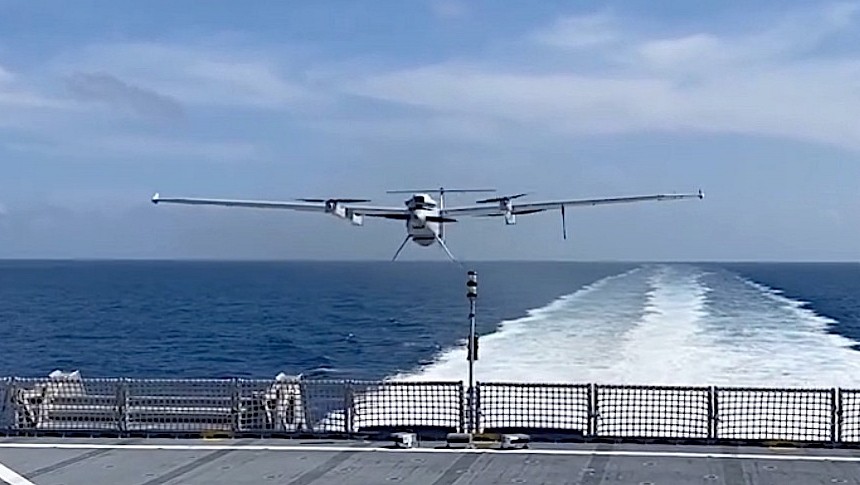There are so many military drones in operation at this time that it is nearly impossible to track what each of them has been up to lately. But even in this very diverse crowd some such vehicles stand out, especially given how they constantly achieve more and more capabilities.
The Jump 20, for instance, is one such hardware. It is officially a vertical take-off and landing medium unmanned aircraft system made by defense contractor AeroVironment. Shaped like an aircraft of smaller dimensions that operates like a helicopter, it has been around for more than a decade.
The drone, which has autonomous capabilities, is deployed in the service of both the American military and some of its allies. Over the years, it clocked more than 130,000 hours of operations across the fleet, and that's saying something.
The thing is, all of those flight hours have been made possible through land-based take-off and landings. To date, the Jump 20 is not used as much for ship-based operations. But that can change after some tests were conducted on the Spearhead-class expeditionary fast transport ship USNS Burlington, and the drone proved its worth.
You see, technically speaking this aerial vehicle is perfectly suited for use on ships. That's because, unlike most other military drones out there, this one does not require launch or recovery equipment. It can take off, fly and land all on its own, with no need for support from personnel.
During the tests conducted recently in the area of responsibility of the U.S. Naval Forces Southern Command, the Jump proved it can lift off, conduct its mission (in this case intelligence, surveillance, reconnaissance, and targeting – ISR-T), and then safely come back. That while the ship was moving at speeds of over 20 knots (23 mph/37 kph).
Neither AeroVironment nor the U.S. Navy gave us any details of exactly what the tests were about, but we are told the drone "exceeded expectations" during its "fully autonomous flight from takeoff to landing."
The technical specifications of the drone do paint some kind of picture of its capabilities, though. The thing can stay airborne for up to 14 hours and moves to distances of up to 115 miles (185 km) from where it departed.
The drone has been built in such a way as to be ready for missions in under an hour from when the order is given. Depending on mission profile, it could be loaded with 30 pounds (14 kg) of gear.
The Jump 20 is one of five drone designs being looked at by the U.S. Army through the Future Tactical Unmanned Aircraft System (FTUAS) program. That's an effort meant to find a replacement for older drones the likes of the RQ-7B Shadow, which was first used more than 20 years ago.
The drone, which has autonomous capabilities, is deployed in the service of both the American military and some of its allies. Over the years, it clocked more than 130,000 hours of operations across the fleet, and that's saying something.
The thing is, all of those flight hours have been made possible through land-based take-off and landings. To date, the Jump 20 is not used as much for ship-based operations. But that can change after some tests were conducted on the Spearhead-class expeditionary fast transport ship USNS Burlington, and the drone proved its worth.
You see, technically speaking this aerial vehicle is perfectly suited for use on ships. That's because, unlike most other military drones out there, this one does not require launch or recovery equipment. It can take off, fly and land all on its own, with no need for support from personnel.
During the tests conducted recently in the area of responsibility of the U.S. Naval Forces Southern Command, the Jump proved it can lift off, conduct its mission (in this case intelligence, surveillance, reconnaissance, and targeting – ISR-T), and then safely come back. That while the ship was moving at speeds of over 20 knots (23 mph/37 kph).
Neither AeroVironment nor the U.S. Navy gave us any details of exactly what the tests were about, but we are told the drone "exceeded expectations" during its "fully autonomous flight from takeoff to landing."
The technical specifications of the drone do paint some kind of picture of its capabilities, though. The thing can stay airborne for up to 14 hours and moves to distances of up to 115 miles (185 km) from where it departed.
The drone has been built in such a way as to be ready for missions in under an hour from when the order is given. Depending on mission profile, it could be loaded with 30 pounds (14 kg) of gear.
The Jump 20 is one of five drone designs being looked at by the U.S. Army through the Future Tactical Unmanned Aircraft System (FTUAS) program. That's an effort meant to find a replacement for older drones the likes of the RQ-7B Shadow, which was first used more than 20 years ago.









